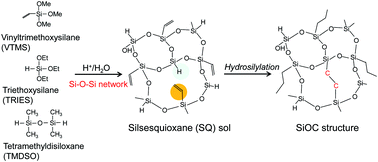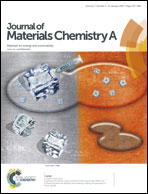Preparation and gas permeation properties of thermally stable organosilica membranes derived by hydrosilylation
Abstract
Thermally stable organosilica amorphous membranes were fabricated by in situ hydrosilylation of vinyl and hydrosilyl groups in Si precursors for the formation of a Si–C–C–Si unit, as well as the Si–O–Si unit via the conventional hydrolysis and condensation of silanol groups. Two types of SiOC membranes (VTT-type prepared by vinyltrimethoxysilane (VTMS), triethoxysilane (TRIES) and tetramethyldisiloxane (TMDSO); and VT-type prepared by VTMS and TRIES) that consisted of a Si–C–C–Si unit created by the hydrosilylation of vinyl and hydrosilyl groups in a Si precursor were fabricated at temperatures higher than 300 °C under N2. Single-gas permeation properties for SiOC membranes at temperatures ranging from 100–500 °C were examined to determine the effect of a silica precursor on the size of an amorphous network. A SiOC membrane (VTT-type) fabricated at 400 °C under N2 showed a H2 permeance of 5.3 × 10−7 mol m−2 s−1 Pa−1 with H2/CO2, H2/N2, H2/CH4 and H2/CF4 permeance ratios of 5.6, 15, 18 and 485, respectively, at 400 °C. The permeance of H2 for a VTT-type membrane heat-treated at 550 °C in air significantly increased from 5.3 × 10−7 to 2 × 10−6 mol m−2 s−1 Pa−1 with a decrease in the H2/CF4 permeance ratio from 485 to 90 due to the combustion of the CH3 groups. The SiOC membrane (VT-type) showed high thermal stability in air at 550 °C with a H2 permeance of 3.0 × 10−7 mol m−2 s−1 Pa−1 and H2/CH4 and H2/CF4 permeance ratios of 50 and 400, respectively, at 400 °C.


 Please wait while we load your content...
Please wait while we load your content...